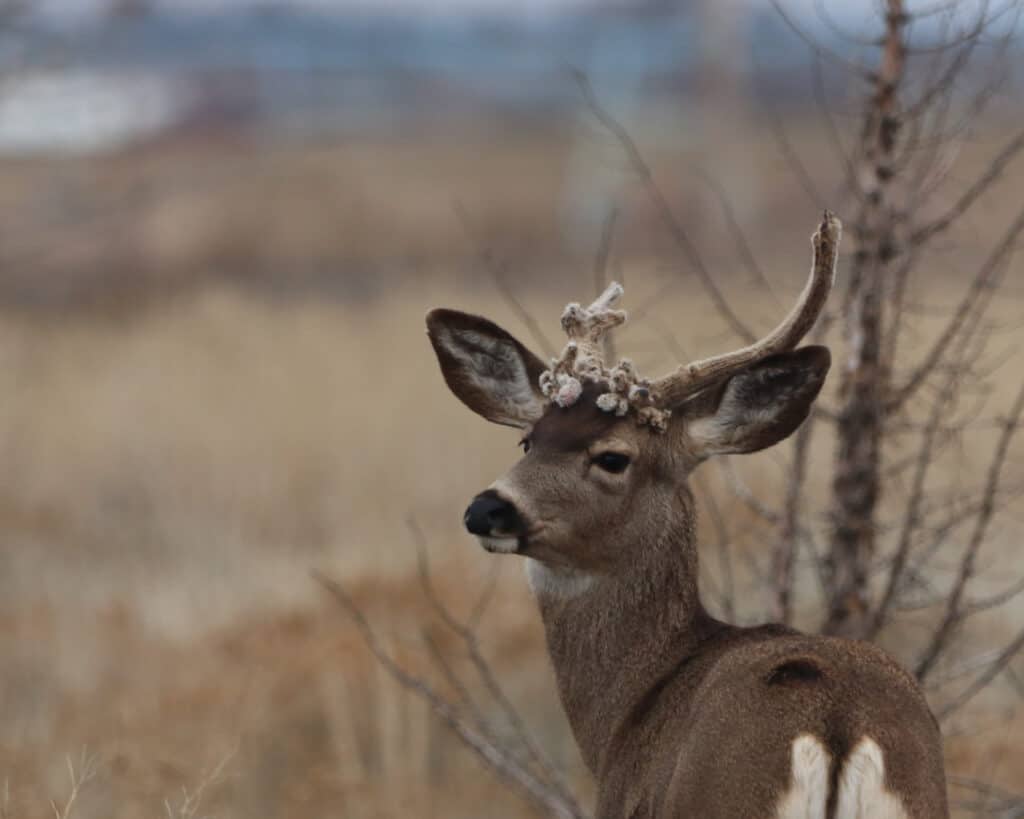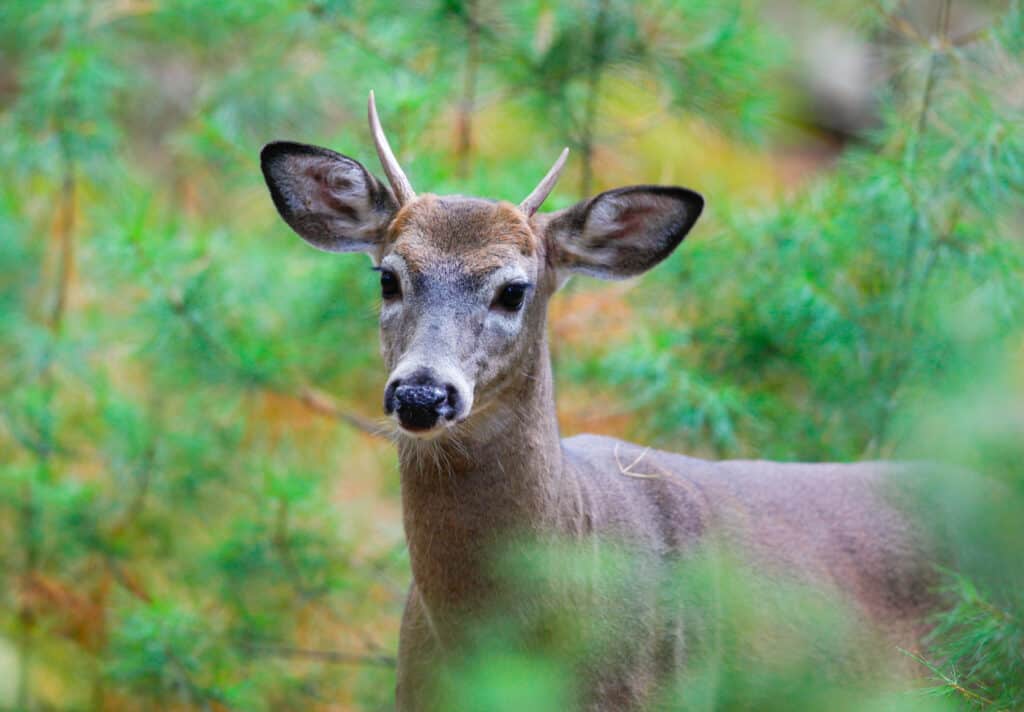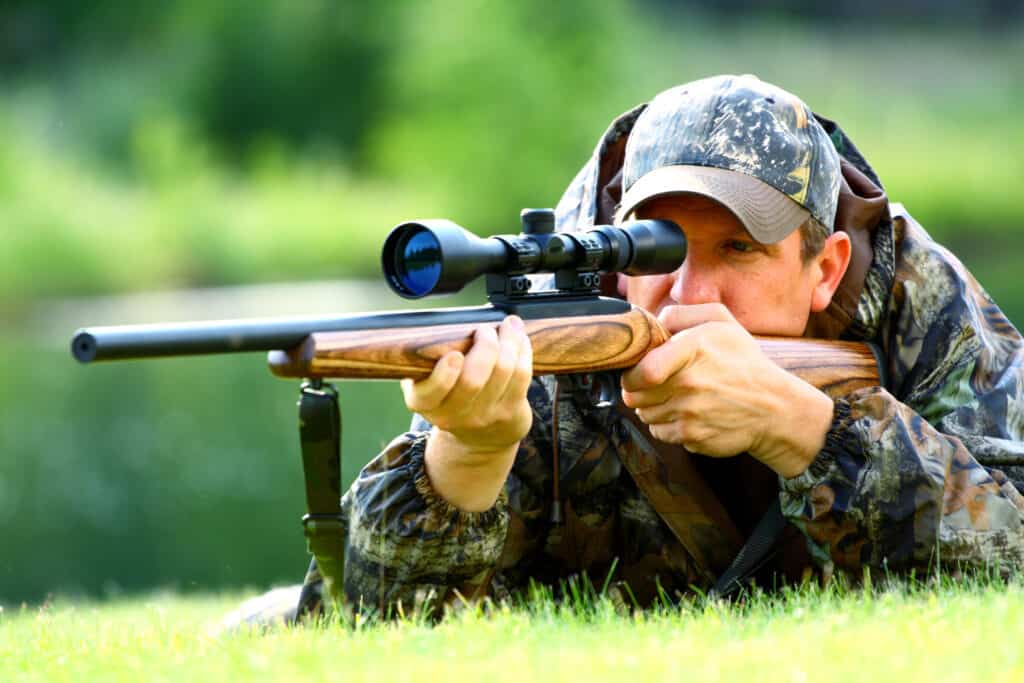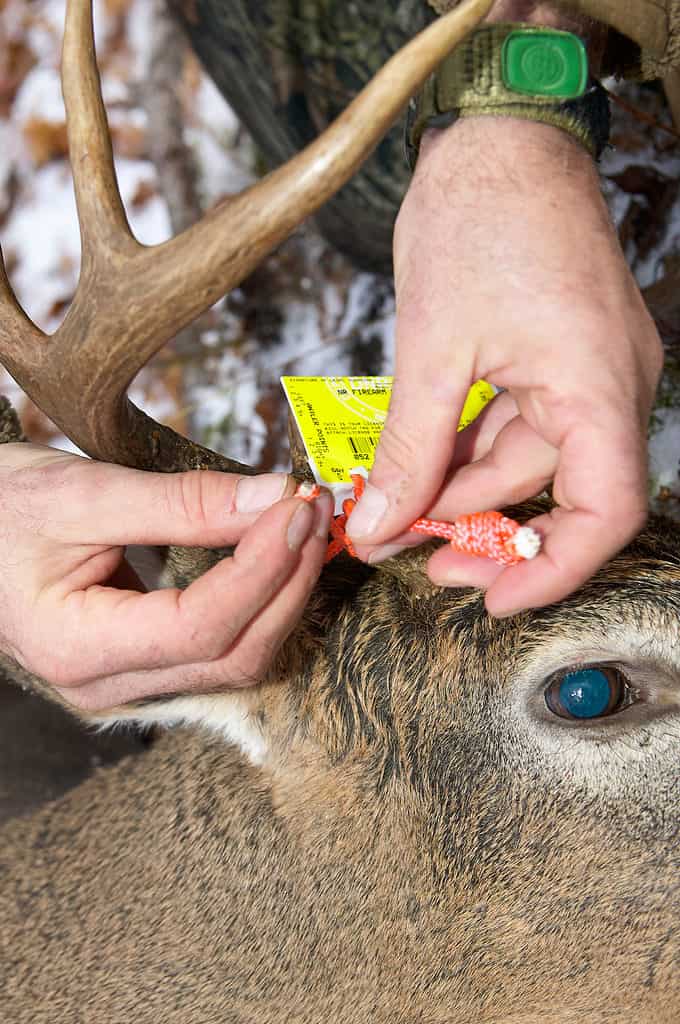Idaho is home to both white-tailed deer and mule deer. White-tailed deer mostly live in the wooded, Northern part of the state. Mule deer are widespread across the desert and mountains. This state allows hunters to take both kinds of deer, though the seasons and regulations for each are slightly different.
Overall, Idaho runs its hunts very similarly to other states. Certain seasons open on certain days. During these periods, you may take deer with approved weapons up to a certain limit. However, Idaho has both controlled hunts and less restricted hunts.
Generally, Idaho tries to allow hunters to take a deer each year. However, this is done at the cost of larger trophy animals. Therefore, the state hosts specialized trophy hunts for those looking to take bigger animals.
We’ll take a look at all the state’s regulations and requirements below.
Hunting Licenses

To hunt deer, you must also purchase a tag for the
season you want to hunt
in.
©iStock.com/Mickilu
To hunt in Idaho, you must purchase a hunting license. To hunt deer, you’ll also need to purchase a permit. However, the hunting license allows you to hunt several other animals, as well.
Hunting licenses are available online, over the phone, or at a licensed vendor. Often, these vendors include sporting goods stores and tackle shops.
There are several licenses for disabled veterans, youth, and non-residents. These vary in price and have their own requirements. If you qualify for one of these special licenses, you’ll need to fill out a special application.
Hunter Education
If you’ve never purchased a license before, you may qualify for the “hunter passport” program. This program allows you to purchase a license for a discounted price without completing a hunter safety course. However, you do have to hunt with a mentor. This mentor must possess a valid hunting license and be at least 18.
Furthermore, you may only purchase this license once. You’ll need to complete the hunter education program and purchase a full-priced license for the next year. The only exception is for 8-10-year-olds, who may purchase a new passport license each year. Only individuals who are at least 8 may purchase this license.
If you don’t qualify for this license, you must take a hunter education course. Everyone born after January 1, 1975, must have a certificate of completion to purchase a license.
These courses are available to everyone over 8. Online and in-person options are available. The course teaches a range of different things, including hunting laws, firearm safety, first aid, and wildlife identification. Courses taken in other states are often valid, as well.
Permits and Tags
To hunt deer, you must also purchase a tag for the season you want to hunt in. Each person is only allowed one tag up to a certain date. After that date, residents may purchase nonresident tags for the nonresident price.
You must also purchase a permit to use archery or muzzleloading weapons. These weapons can be used during “archery only” and “muzzleloader only” seasons. Controlled hunts also require these permits.
Types of Hunting Seasons
There are two types of hunting seasons in Idaho: general and controlled. These are different from hunting seasons in other states. Therefore, it’s important for out-of-state hunters to understand these seasons.
General seasons are arranged by unit. Some of these seasons are labeled “regular deer,” “white-tailed,” or “mule.” This label specifies which species you can hunt. “Regular deer” allows you to hunt all deer, while the other seasons are species-specific.
Controlled hunts are only available in controlled areas. These areas are different for each species. These hunts must be applied for and won via lottery. They usually allow for larger deer to be taken.
Typically, the bag limit allows only one deer to be taken per year. However, unpurchased nonresident deer tags can be bought at nonresident prices. These are limited in quantity.
Antlered vs. Antlerless Deer

The state of Idaho does not draw lines based on the sex of the deer – but on whether or not the animal has antlers.
©iStock.com/Louise Wightman
There are several seasons labeled “antlered” or “antlerless.” These seasons allow you to take only specific kinds of deer. The state of Idaho does not draw lines based on the sex of the deer – but on whether or not the animal has antlers. Sometimes, specific antler requirements are in place, too.
Antlered deer must have an antler of at least three inches. In an antlered-only season, the antlers must stay with the carcass until it is processed. Antlerless deer are any deer that don’t fit the previous subscription.
If antler restrictions are in play, only certain antlered deer can be taken. For instance, two-point deer seasons require that the deer have no more than two points on both sides. “Spike” deer and deer with up to two points on each side are valid. However, if one side has three or more points, it is not allowed.
Three-point hunts are similar. However, they allow deer with up to three points on one side to be taken. Therefore, only four points and up are not allowed during these seasons.
Species Restrictions
There are several seasons where the species is restricted. In these cases, the tail of the deer must be kept with the animal until it is processed. Be sure to identify your deer before you take it to ensure you’re taking the correct species.
Youth Hunt Information
Idaho has several youth hunts. During these periods, only hunters between the ages of 10 and 17 may hunt. The individual must apply for the youth-only hunt, as it is a controlled hunt. Nine-year-olds may also apply if they will be ten by the time of the hunt.
Residents younger than 12 must be accompanied by an adult of at least 18 years of age who has a hunting license. The adult and child must remain close together – within the range of normal conversation.
All individuals with a hunting passport must be accompanied, as well. However, individuals with a hunter education certificate and is over 12 may hunt without a mentor.
Basic Wildlife Hunting Laws
Idaho has some laws that cover all hunting of big game animals. Both deer species fall into this category, so these rules apply to them.
You may only hunt for one-half hour before sunrise to one-half hour after sunset. Hunting means “chasing, driving, stalking, or shooting at” any animal. It doesn’t matter whether that wildlife is then taken and killed or not.
You may not take more than one deer per calendar year unless you purchase another tag. These are in limited supply and not always available.
After the hunt is completed, you must report your hunt for each tag you purchase. If you harvest a deer, this must be done within ten days. However, if you do not harvest a deer, you must report up to ten days before the end of the season. You can do this online and via phone.
All edible meat must be taken from most big game animals, including deer. This doesn’t include the meat of the head, neck, ribs, or internal organs. You may also leave some meat on the bones, though the trimming should be close.
If you injure an animal, you must try to retrieve it. However, it is unlawful to enter private property when it is posted. If you believe a wounded animal has wandered onto private property, it is recommended to ask the landowner for permission to retrieve it.
No electric call can be used to lure deer.
There are several other restrictions, as well, including:
- “Party hunting”
- Shooting across a road
- Using unmanned aircraft systems (aka drones)
- Failing to stop at a check station
- Failing to produce wildlife for inspection
- Using a spotlight or flashlight to hunt
- Using dogs to hunt big game
- Intentionally interfering with another’s hunt
Trespassing Laws
Trespassing is a big deal in Idaho. However, the laws are a set up a bit differently than in other states. It is illegal to go on someone’s land without permission, even when you’re following a wounded animal. However, there are several “accepted” signs that would cause the person to know the land is private.
Therefore, if these signs are present, then the individual may not have known they were trespassing. In these cases, it really isn’t trespassing under the law (unless it can be proven that the hunter knew they were trespassing).
These signs include:
- An obvious house or business associated with the land
- Cultivated fields
- A fence or enclosure setting the land aside
- Conspicuous “no trespassing” signs or bright orange paint
Only one of these signs is needed to prove trespassing.
Weapon Requirements
Each type of weapon able to be used in hunting must meet certain criteria. Only certain weapons can be used in certain seasons.
Airguns, Shotguns, and Rifles

You may not attach electronic devices to your firearm, except in the case of battery-powered scopes.
©timotheos/Shutterstock.com
These weapons can be used during firearms and any-weapon seasons. You must only utilize approved guns, however. Seasons that allow for firearms to be used also allow for archery equipment and muzzleloaders.
You may not attach electronic devices to your firearm, except in the case of battery-powered scopes. The firearm can never weigh more than 16 pounds, including the sling, scope, and other attachments. The weapon cannot be fully automatic.
Shotguns must use buckshot bigger than #00. Rimfire handguns, rimfire rifles, and muzzleloading handguns are also prohibited altogether.
Short Range Weapons
Idaho has a distinction for “short-range weapons” that are allowed in certain areas. These weapons typically are allowed instead of other firearms in areas with a higher population.
These weapons on include certain types of firearms and archery equipment:
- Shotguns with a slug or double-aught buckshot
- Muzzleloaders of at least 0.45 caliber
- Bows having a max draw weight of 40 pounds
- Crossbows with a draw weight of at least 150 pounds
- Handguns using centerfire or straight wall cartridges
- Airguns that propel a projectile with unignited compressed air. The gun must shoot at least 0.35 caliber.
Muzzleloaders
You must have a muzzleloader permit to hunt with this sort of firearm during any season. Muzzleloading pistols are not allowed, which leaves only rifles and muskets.
These weapons must be only loaded from the muzzle. Only open and peep sights are allowed. Any electronics on the scope are prohibited. The only exception is for hunters with disabilities.
Only black powder in a loose form or a similar alternative may be used. The projectile must be within 0.10″ of the bore. You may not use sabots ever. The ball or projectile must be made of lead.
Archery
There are a lot of restrictions and requirements for archery equipment. Therefore, you need to look at these regulations carefully to ensure you’re within the legal limit.
The broadheads must measure 7/8″ or more. The cutting edge must be larger than 0.015″ thick. Most bows utilized must have a 40-pound draw weight at least. Crossbows have a bigger draw weight requirement of at least 150 pounds. The bolt or arrow must be at least 300 grams, including the broadhead, and be at least 12″ from the broadhead to the nock.
You cannot use any chemicals or explosives attached to the arrows. Electronic devices are also prohibited. However, the only exception is lighted nocks. Hunters with some disabilities may be exempt from this restriction.
Bows that can shoot more than one arrow at a time aren’t allowed.
Airguns
Airguns are allowed in seasons that allow for firearms. They must be pre-charged and run on pneumatic power to propel a projectile. Shot and arrows are not allowed to be the projectile, though. The compressed air must be unignited, and you must use at least 0.35 caliber.
While it isn’t required, it is recommended that the airgun produce at least 350 foot-pounds of force.
How to Tag and Transport a Deer

Once you kill the deer, you must remove the triangles on your tag that designate the day and month of the kill.
©CLP Media/Shutterstock.com
Once a deer is harvested, there are several steps you must take. Once you kill the deer, you must remove the triangles on your tag that designate the day and month of the kill. These must be removed completely and cleanly. You cannot simply tear or punch the tag.
You cannot use any tag that has been altered. It must be just as you received it except for the appropriate notching.
Once the tag is notched, you must attach it to the animal. This tag must remain with the carcass or a portion of the meat. The tag may only be removed when the meat s processed and reaches the final place of storage.
You may have someone else transport the deer. However, you must provide them with a “proxy statement” that indicates some identifying information, such as your name and license number.
You must maintain proof of sex when transporting the deer. Often, the head and antlers can be used for this. If they are removed, you must use a sex organ instead. This must remain naturally attached to the carcass while transporting it. It may only be removed when the animal is being processed.
If you’re hunting in an antler-restricted season, then you must keep the head and antlers attached to the carcass.
In seasons of restricted species, you must keep the fully-haired tail on the carcass or a portion of the edible meat. Often, it is recommended to skin the tail to leave it attached to the boned meat or saw through the tail bone.
Common Hunting Violations
There are several hunting violations that are quite common. Often, these violations are due to misunderstandings or not understanding the rules.
One of the most common violations is purchasing the wrong license class. Often, this occurs when a non-resident purchases a resident license. While non-resident licenses are more expensive, you must purchase one if you do not live in Idaho.
Another is possessing big game without proof of the sex. Be sure that evidence of the sex is left naturally attached to the carcass.
Unlawfully taking a deer is also a common violation. Usually, this involves hunting outside of the appropriate season, zone boundaries, or shooting the wrong deer. Using the wrong weapon also falls into this category. Be sure you know where, when and what you’re hunting.
Hunting without a tag (or with the wrong tag) is also common. You need to ensure that the type of tag you’re using lines up with what you’re hunting.
Up Next:
The photo featured at the top of this post is © iStock.com/Jeff Edwards
Thank you for reading! Have some feedback for us? Contact the AZ Animals editorial team.






